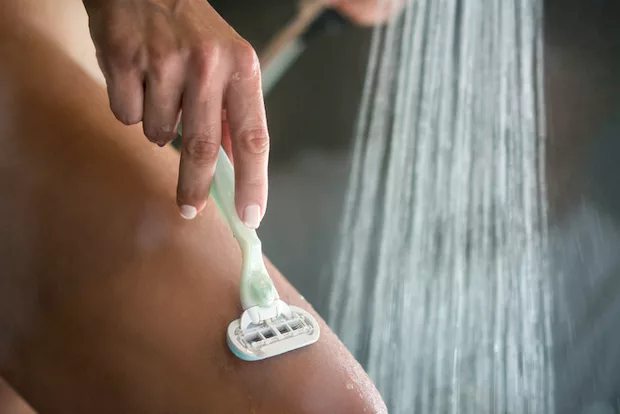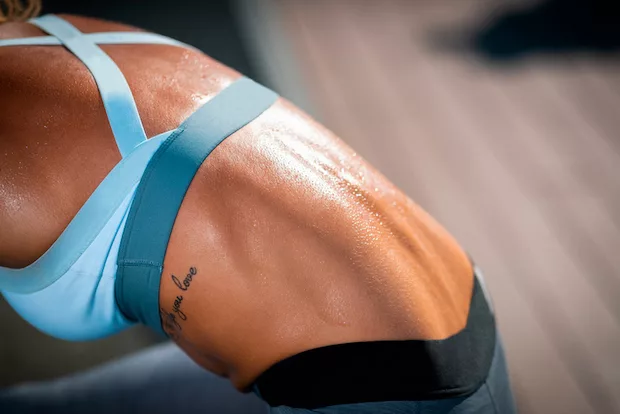It’s possible to get pimples in the vaginal area, including on your labia or bikini line. But sometimes, it’s not actually vaginal acne at all… so what gives? Two derms and an OB-GYN share everything you need to know about pimples on your private parts.
It’s never fun to wake up to an angry-looking breakout. But when pimples crop up in your vaginal area, it’s even worse. While one might think that a breakout in a place that can easily be covered with underwear or clothes wouldn’t be as dreadful as a pimple in a much more conspicuous place, like your face, that’s often not the case. Thanks to society’s continuously unattainable beauty ideals, the media—social media most definitely included—prioritizes blemish-free bodies. So when you get a pimple on your labia or surrounding area, it’s easy to get flustered by the situation.
In an effort to soothe your sorrows, we’re here to shed light on the down-there acne that often gets overlooked: pimples on your private parts. Ahead, learn what causes vaginal acne, how to determine if they’re actually breakouts, how to combat them, and more.
What Causes Pimples on Your Private Parts?
Let’s first clear something up: While pimples in the vaginal area are often thought to be a form of acne, board-certified dermatologist Tiffany Clay, MD, says that nine times out of 10, it’s actually folliculitis (aka hair follicle inflammation).
Folliculitis can be caused by a number of things. “Leaving on tight, occlusive clothing after a sweaty workout is a very common factor that leads to follicle and pore blockage and increased trapped bacteria,” Dr. Clay says, noting that the bacteria can cause infections that pop up in the form of pimple-like pustules. “Another factor that may cause an inflammatory bump is having an ingrown hair, which when trapped under the skin can cause swelling, pain, redness, and sometimes pus formation.”
Speaking of ingrown hairs, OB-GYN Ruth Arumala, MD, says that hair removal techniques are often the culprit. Shaving with a dull razor (especially against the grain) and getting waxed—which is often thought to be safer and more effective than shaving—can both cause inflammation around the follicles, which in turn can transform into anything from a small pimple to a sebaceous cyst. “The severity ranges from mild to severe and [each] has different inciting and aggravating factors,” Dr. Arumala explains.
As for *where* pimples down there set up shop, Dr. Arumala says that they’re most often found on the mons pubis and labia majora, both of which are hair-bearing areas, thus making them prone to folliculitis. That said, she points out that Bartholin gland cysts and vaginal inclusion cysts also exist and are often mistaken for large zits. These lesions occur along the sides of the opening of the vagina, as well as along the vaginal canal, and aren’t actually breakouts. “These are treated differently from the pimples [in the vaginal area],” Dr. Arumala says.

How to Clear Pimples in the Vaginal Area
Naturally, you’ll first want to make sure that they’re actually pimples. If your “breakouts” are along the interior rim of your vagina or deeper within the canal, make an appointment with your OB-GYN before attempting to take matters into your own hands.
Otherwise, if your breakouts are on your pubic area (i.e., along your pubic bone and bikini line) or labia majora, learn how to proceed, below.
As is the case with facial acne, prodding, picking, or trying to pop the pimples on your private parts may be tempting—but these methods are far from ideal. “When we pop pimples, we allow the bacteria and debris-rich contents of the pus-filled pustules to escape and disseminate around the surrounding skin,” says Michelle Henry, MD, a board-certified dermatologist and the founder of Skin & Aesthetic Surgery of Manhattan. “Instead, our focus should be to minimize discomfort and reduce the size of the pimple itself.”
Use a Topical Acne Wash
Dr. Clay agrees with Dr. Henry’s hygiene-first, easy-does-it approach. She recommends using a gentle topical acne wash with five percent benzoyl peroxide or two percent salicylic acid. In addition to minimizing the inflammation of the present breakouts, she says that these ingredients will help prevent future breakouts in your nether regions, too.
P.S. If you’re dealing with facial breakouts as well, don’t forget to complement your skin-clearing routine from within with HUM’s Daily Cleanse.
Try the Q-Tip Extraction Method or Steaming with a Warm Cloth
Now, if the idea of being patient and waiting for the pimple to resolve on its own is too much to bear and you simply must take matters into your own hands, Dr. Arumala says to do so with the utmost care.
“You should wash your hands thoroughly first, then cleanse the area with a gentle cleanser,” she says. “Then isolate the area and express the sebaceous contents using two cotton tips to prevent bacteria on your hands from being transferred to the lesion.” If this technique works and pus seeps out, Dr. Arumala advises using clean tweezers to pluck the agitating hair, as it will likely have popped out, as well.
If you find that your pubic pimple is deep-rooted, don’t squeeze it aggressively hoping that it will burst open. Instead, Dr. Arumala says you can use a gentle steaming method with a warm cloth to help loosen the pores so that the clogged debris will extract more easily.
Consult Your Derm
If the steps above don’t work—or if you want to take the safest route—book an appointment with your dermatologist.
“If you have a very painful, stubborn pimple, I recommend seeing a dermatologist,” Dr. Clay says. “We can look closely for an ingrown and remove it, inject cortisone in it if needed to alleviate the inflammation quickly, and also drain it if there is a large pus collection.”
What’s more, some more aggressive breakouts may require a topical or antibiotic to be prescribed, and they can help with that.

3 Tips to Combat Vaginal Acne
Since pimples on your private parts are most often caused by excess friction on hair follicles, it’s important to reduce it as much as possible. With that in mind, be sure to heed these expert-backed tips to reduce the chances of new pimples from forming on your private parts:
1. Try Out Trimming
You may want to reconsider your hair removal methods (if you choose to remove your hair at all). As convenient as shaving or waxing may seem, if pimples in the vaginal area are all too common for you, Dr. Arumala says that trimming may be your best bet. Trimming puts less tension on each hair, so it’s less likely to irritate the follicles. “The Bushbalm Francesca Body + Bikini Trimmer ($65) is gently removes hair without irritating the underlying epidermis,” she shares.
2. Be Mindful of Your Clothing Choices
Another key thing you can do is limit time in ultra-tight clothing like leggings, as they can cause friction on your pubic area. Additionally, Dr. Clay says to change out of workout clothes and shower as soon as possible to reduce the potential for bacteria to get trapped in your pubic pores.
Dr. Arumala says that opting for cotton varieties of underwear can also help, as they’re more breathable and less likely to trap bacteria. Some of our favorite cotton undies include the Knickey Organic Cotton High-Rise Brief ($17) and Knickey Organic Cotton High-Rise Thong ($17).
3. Exfoliate Your Pubic Area
While in the shower (or after you hop out), Dr. Clay recommends exfoliating your pubic area. Some options include the Bushbalm Ingrown Hair + Razor Bump Minimizer Kit ($49), as well as the First Aid Beauty Ingrown Hair Pads with BHA & AHA ($20), which are especially great for on-the-go use, including for travel and trips to the gym.
The Takeaway
Look, pimples happen—and they can pop up anywhere on your body, including your vaginal area. If you notice small pustules on your pubic bone, bikini line, and labia majora, the treatment techniques and prevention methods shared above can help.
If, however, you discover bumps along your vaginal opening and within the vagina itself—or if you’re experiencing painful, deep-rooted pimples anywhere down there that seem unfazed by treatments—your best course of action is to call up your dermatologist or OB-GYN to get professional guidance.
Build Your Supplement Routine
Take The HUM Quiz
The post How to Get Rid of Vaginal Acne Without Making It Worse appeared first on HUM Nutrition Blog.
---------------------------
By: Rebecca Norris
Title: How to Get Rid of Vaginal Acne Without Making It Worse
Sourced From: www.humnutrition.com/blog/vaginal-acne-pimples/
Published Date: Thu, 26 Jan 2023 23:36:13 +0000
Read More
 General Health and WellnessFitness and ExerciseSupplements and VitaminsPandemic NewsVideosPrivacy PolicyTerms And Conditions
General Health and WellnessFitness and ExerciseSupplements and VitaminsPandemic NewsVideosPrivacy PolicyTerms And Conditions
